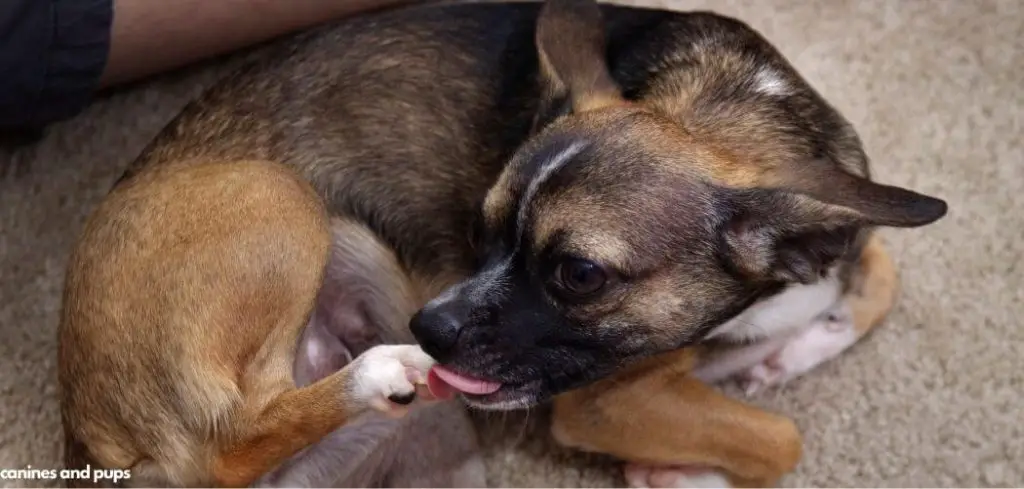If a dog is drooling excessively and constantly licking its paws, it can be alarming for any dog owner. These behaviors often signal underlying issues ranging from allergies to more serious health conditions.
We outline the common causes of excessive drooling and paw licking in dogs, what you can do, and when to seek veterinary help.
Dog Drooling Excessively and Licking Paws — Why It Happens
When a dog is drooling a lot while also licking its paws, it is usually a sign that something is irritating its mouth, throat, or paws. Allergies, infections, dental disease, or foreign objects can trigger these symptoms. Anxiety and stress may also play a role, while in some cases, nausea or toxin exposure could be the culprit.
Because the causes range from mild to potentially dangerous, it’s important to watch closely for other signs.

Excessive Drooling and Paw Licking in Dogs: Common Causes
Allergies
Allergies are one of the most common reasons a dog will drool and lick its paws. When a dog comes into contact with allergens like pollen, dust, or certain foods, their immune system reacts with inflammation and irritation.
This often causes itchy paws, leading the dog to lick them for relief. Excess drooling may happen if the allergic reaction affects the mouth or throat.
You may also notice red skin, constant scratching, or watery eyes alongside these behaviors.
Allergies can be uncomfortable but also lead to secondary infections if untreated.
Related: Dog Excessively Licking and Biting Paws (Here’s Why)
Dental Disease
Dental problems such as gingivitis, periodontal disease, or broken teeth can cause excessive drooling. When a dog is in oral pain, drool production increases.
A dog with dental issues might lick its paws frequently as a coping behavior, similar to chewing or pawing at the mouth. Bad breath, difficulty chewing, or pawing at the face are additional warning signs.
Dental disease can worsen quickly, leading to severe pain and even systemic infections if not treated promptly.
Foreign Objects
If something is stuck in a dog’s mouth, throat, or even between its paw pads, drooling and licking are common reactions. For example, grass awns, splinters, or small bones can lodge in these sensitive areas.
The irritation causes drooling as the body attempts to expel the object, while paw licking may happen if the paws are directly affected. Owners may also see paw chewing, limping, or sudden distress.
Foreign bodies can quickly become dangerous, especially if lodged in the throat or causing deep paw infections.
Infections
Both oral and paw infections can trigger this combination of symptoms. An infected tooth or gum may lead to drooling, while a fungal or bacterial paw infection causes licking.
Redness, swelling, foul odor, or pus around the affected area are strong clues. Dogs may also avoid eating or walking normally due to discomfort.
Infections should never be ignored, as they can spread or worsen, leading to more serious complications.
Stress and Anxiety
Dogs under stress often develop repetitive behaviors like paw licking. Excess drooling can also be a physical response to anxiety.
Situations such as loud noises, separation anxiety, or unfamiliar environments may trigger these behaviors. In some cases, the drooling is stress-induced rather than related to a physical illness.
Chronic anxiety not only affects quality of life but can also lead to skin damage from constant paw licking.
Toxin Exposure or Nausea
Toxins, certain plants, or ingesting spoiled food can cause nausea and drooling. Some toxins may also cause irritation that leads to paw licking.
If a dog suddenly develops these symptoms after being outdoors or scavenging, poisoning could be the cause. Vomiting, diarrhea, tremors, or lethargy may also appear.
This is a medical emergency and requires immediate veterinary care.
Read more: Dog licking paws excessively (When to worry)
What to Do If Your Dog Is Drooling Excessively and Licking Its Paws
Start by calmly observing your dog. Check its mouth and paw pads for visible injuries, foreign objects, or swelling. If you see something stuck that is safe to remove, do so carefully. However, avoid forcing anything that could hurt your dog further.
Wipe your dog’s paws with a damp cloth after walks to reduce allergens and irritants. If allergies are suspected, keeping the home environment clean and washing bedding can help. Dental chews and regular tooth brushing may ease mild oral irritation.
If stress appears to be the trigger, providing comfort, toys, or a calm environment may reduce symptoms. Keeping a journal of when the drooling and licking occur can also help identify patterns.
Always monitor your dog closely. If symptoms persist or worsen, professional care is necessary.
When to Call or Visit Your Vet
Seek veterinary help immediately if your dog shows signs of choking, paw swelling, blood in the saliva, or sudden, severe drooling. These can indicate foreign objects, infections, or toxin ingestion.
If the paw licking is relentless and causing hair loss or sores, a vet visit is needed to prevent secondary infections. Excess drooling with refusal to eat, vomiting, or lethargy also warrants urgent evaluation.
Even if the symptoms seem mild, persistent drooling and paw licking should be checked to rule out underlying illness. Timely intervention can prevent bigger health problems down the road.
Read more: Dog drooling excessively (Possible causes explained)
Key Takeaway
Dog drooling excessively and licking paws can point to many different issues, from minor irritations to serious health problems. While some causes are simple, like allergies or anxiety, others like dental disease, infections, or toxin exposure need urgent care.
If your dog’s symptoms are ongoing, severe, or accompanied by other signs like vomiting, refusal to eat, or swelling, don’t delay contacting your veterinarian. With prompt attention and care, most dogs can find relief and return to their happy, healthy selves.
